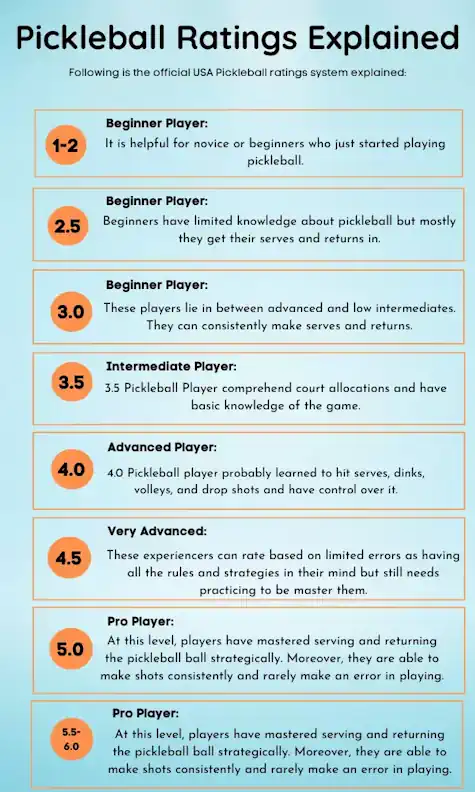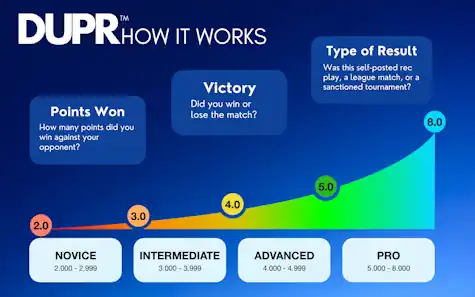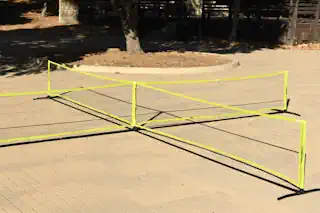Understanding the Pickleball Rating System: A Beginner Guide

Pickleball, a sport burgeoning in popularity, has its own unique rating system that helps players of all levels gauge their skills and compete fairly. Whether you’re a seasoned enthusiast or just getting started, understanding how the pickleball rating system works can significantly impact your game and overall experience. Let’s dive into the nuts and bolts of pickleball ratings, explore different systems, and learn how they shape the sport and assess your pickleball skills.
Introduction to Pickleball Rating Systems
Pickleball player ratings might seem like a modern invention, but their roots go back to the early days of the sport. Initially born out of necessity to ensure fair play during friendly matches, these systems have evolved into formalized methods used globally. Ratings are more than just numbers; they reflect a player’s skill level, experience, and competitive edge.
Many pickleball players have other sports background where skill assessment sheets and a rating algorithm are very common. If you aspire to join the ranks of professional pickleball players your rating in both league play and tournament play will be very important to your progression. Working with sanctioned and official rating structures helps all players anticipate their opponent’s strengths and weaknesses.
Understanding the Basics
Before we delve deeper, let’s break down the fundamentals of pickleball rating systems:
Overview of Common Rating Systems
The world of pickleball primarily revolves around a few key rating systems, each with its own methodology:
USAPA Rating System: The United States of America Pickleball Association (USAPA) rating is the most widely recognized. It meticulously categorizes players from beginners to pros.
IFP Rating System: The International Federation of Pickleball (IFP) offers another standardized rating, often used in international tournaments.
Glicko-2 Rating System: An intricate system that adjusts player ratings based on the uncertainty of their performance, making it highly dynamic and responsive.
DUPR (Dynamic Universal Pickleball Rating): A relatively new and innovative system that uses algorithms to provide a real-time, dynamic rating. DUPR captures and updates player performance across all levels and venues, offering a comprehensive and up-to-date reflection of a player’s skill set.
How Pickleball Ratings Are Determined
Typically, beginner ratings start at 2.0, while advanced players can boast ratings up to 5.0. Factors influencing ratings include:
Match Outcomes: Wins and losses against similarly-rated players.
Skill Assessments: Evaluations based on technical and tactical abilities like soft shots, power shots, medium paced shots, overhead shots, drop shots, and lob shots .
Tournament Performances: Success in competitive play often leads to rating adjustments.
How to Sign Up for a Rating System
Embarking on your journey to get rated in the pickleball tournament player ratings, is simple and rewarding. Here’s a step-by-step guide to help you sign up for the most popular rating systems:

USAPA Rating System:
Become a Member: Visit the USAPA Membership page tosign up. Membership provides access to a wealth of resources, including events, tournaments, and the official rating system.
Participate in Sanctioned Events: Play in USAPA-sanctioned tournaments, as your performance in these events will contribute to your rating. Check the USAPA Tournament Calendar for upcoming events.
Utilize Player Profile Tools: Once you’re a member, you can update your player profile and track your progress through the official USAPA website.
IFP Rating System:
Join the IFP Community: Start by registering on the IFP website and exploring the membership benefits.
Global Tournaments: Participate in IFP-recognized tournaments around the world. Your performances in these events will be recorded and reflected in your IFP rating.
Stay Connected: Use the IFP platform to stay updated with news, events, and your rating progression.
Glicko-2 Rating System:
Connect with Local Clubs: Many local pickleball clubs and leagues adopt the Glicko-2 system. Find a club that uses Glicko-2 through community boards or online searches.
Enroll in Leagues: Enroll in local or regional leagues that utilize the Glicko-2 system for ongoing assessments and rating adjustments based on your match outcomes.
DUPR (Dynamic Universal Pickleball Rating):
Register Online: Head over to the DUPR website and create an account. Registration is free and open to all players.
Utilize the DUPR App: Download the DUPR mobile app for easy access to your profile, match history, and rating. It also offers features to find other rated players and upcoming events.
Sync Your Matches: After registering, you can manually enter match results or sync with affiliated venues and tournaments. The algorithms will process the data and provide real-time updates to your rating.
No matter which system you choose, signing up and actively participating will provide a clearer picture of where you stand in the pickleball community. It’s a great way to challenge yourself, track your improvement, and connect with fellow enthusiasts who share your passion for the game.
In-Depth Look at Popular Rating Systems
USAPA Rating System
The USAPA rating system is perhaps the cornerstone of pickleball competitions in the United States. It uses a combination of self-assessment, peer reviews, and observed play to categorize players accurately. Regular updates ensure that as pickleball players improve, their ratings reflect this progress.

Comparing USAPA with IFP and Glicko-2 and DUPR
USAPA vs. IFP: While both are similar, the IFP serves a global audience, making slight adjustments to accommodate international players’ diverse styles.
USAPA vs. Glicko-2: The Glicko-2 system is more dynamic, adjusting ratings more frequently based on match outcomes, and includes a factor for rating reliability.
USAPA vs. DUPR: The USAPA system is well-established and largely static, relying heavily on structured assessments and match results to update ratings periodically. In contrast, DUPR offers a more fluid and real-time approach, utilizing advanced algorithms to provide instant updates based on a player’s most recent performances. This dynamic nature makes DUPR particularly appealing for players who frequently participate in matches and tournaments, as it reflects their current skill level more accurately and promptly. Some consider DUPR a more accurate rating system.
The Impact of Ratings on the Game
Influence on Gameplay and Tournaments
Ratings influence everything from match pairings to tournament brackets. Playing against similarly rated opponents ensures a competitive yet enjoyable experience. In tournaments, ratings determine seeding, which can have a significant impact on the progression and experience of the event.
If you are considering signing up for a tournament be sure to check which rating system the tournament organizers want you to have. Not all local areas support all rating systems and if you are only DUPR rated but the tournament wants you to be USAPA rated you will have to register and potentially petition for your rating to transfer.
Insights from Experienced Players
Many seasoned players have shared how understanding and improving their ratings has enhanced their game strategies and overall enjoyment. They emphasize the importance of regular tournament play and seeking opportunities to challenge themselves against higher-rated opponents.
Tips for Beginners
Improving Your Rating
If you’re just starting, here are some tips to help you climb the rating ladder:
Regular Play: Consistency is key. Engage in regular matches with players slightly above your current rating.
Skill Development: Focus on both technical skills (like serves and volleys) and tactical skills (such as positioning and shot selection).
Professional Coaching: Consider investing in a few sessions with a certified coach who can offer personalized advice.
Setting Realistic Goals
It’s essential to set achievable goals based on your rating. For instance, aim to move self rating from 2.0 to 2.5 within a few months by practicing specific skills and participating in local tournaments.
Future of Pickleball Rating Systems
Trends and Innovations
The future of pickleball ratings looks promising, with advancements like:
AI and Data Analytics: These technologies could provide more precise and real-time assessments of player performance.
Global Standardization: Efforts are underway to unify rating systems worldwide, making it easier for players to compete internationally.
Predictions for Evolution
Expect rating systems to become even more sophisticated, incorporating factors like player fitness levels and psychological resilience, offering a holistic view of player capabilities.
Conclusion
Understanding the pickleball skill rating system is crucial for anyone serious about the sport. It not only helps players track their progress but also ensures fair and balanced competition. By embracing these systems, you can set realistic goals, improve your gameplay, and fully immerse yourself in the vibrant pickleball community.
Frequently Asked Questions (FAQ)
What is the best rating system for beginners?
While all rating systems serve their purpose, the DUPR system is particularly user-friendly for beginners due to its fluid and real-time updates. This can provide new players with a more immediate sense of progression and help track improvements effectively.
How do I get started with the USAPA rating system?
To get started with the USAPA rating system, you need to create an account on the USAPA website and participate in officially sanctioned tournament play. Your performance in these sanctioned tournaments will be assessed and contribute to your rating.
Can I use multiple rating systems simultaneously?
Yes, many players are rated in multiple official rating systems. For instance, you might have both a USAPA and DUPR rating to ensure you’re prepared for any tournament requirements and to track your progress from different perspectives.
How often are ratings updated in these systems?
The frequency of updates varies by system. DUPR ratings are updated in real-time after each match result is entered or synced. The USAPA rating system is updated periodically after formal assessments and documented tournament play, which might not be as frequent.
Can my rating change if I engage in recreational play?
In some provisional rating systems, like DUPR, you can manually enter informal match results which can affect your rating. However, for the USAPA rating system, only matches played in officially sanctioned events are considered.
What if my local tournament doesn’t support my rating system?
If a tournament requires a different rating system than the one you’re using, you’ll need to register with the required system and potentially have your existing rating evaluated or transferred. It’s crucial to check this information well in advance of the tournament.
How do player ratings impact the pickleball community?
Player ratings foster a sense of fairness and structure within the pickleball community. They help ensure that matches and pickleball tournaments are competitive and enjoyable for all participants, by matching players of similar skill levels against each other.
Are there resources available to help improve my rating?
Absolutely! Many resources can help you improve your pickleball self-rating, including professional coaching, instructional videos, regular practice sessions, and participating in local clubs and tournaments. Engaging with the pickleball community is also a great way to gain insights and tips from more experienced players. A pickleball player’s skill level should improve with regular and consistent play.





